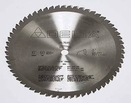 Table saw kickback is, plainly and simply, gnarly; its frightening, dangerous, damaging and surprisingly common. Kickback occurs during a cut when, for one of a few reasons, a piece of wood stock is violently flung from a table saw and back towards its operator. The stock is propelled by the force and momentum of the saw’s engaged blade and catapulted back at the user at speeds that can reach (or exceed) one-hundred miles per hour. Accordingly, it is not unheard of for a piece of material to lodge itself into a wall, to damage other shop equipment, or to cause serious injury (and, although less commonly, death) to the user behind the machine. In short, table saw kickback can be pretty terrifying.
Table saw kickback is, plainly and simply, gnarly; its frightening, dangerous, damaging and surprisingly common. Kickback occurs during a cut when, for one of a few reasons, a piece of wood stock is violently flung from a table saw and back towards its operator. The stock is propelled by the force and momentum of the saw’s engaged blade and catapulted back at the user at speeds that can reach (or exceed) one-hundred miles per hour. Accordingly, it is not unheard of for a piece of material to lodge itself into a wall, to damage other shop equipment, or to cause serious injury (and, although less commonly, death) to the user behind the machine. In short, table saw kickback can be pretty terrifying.
How is Kickback Caused?
Table Saw Limitations:
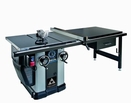 The kickback phenomenon is the result of a variety of defects existing with or caused by the saw, the blade, the stock and, of course, by the operator. In fact, the majority of table saw kickback accidents are the result of operator error. To begin, however, with machinery limitations, kickback commonly occurs where lower power machines are asked to perform tasks that are too aggressive. When confronted with a catch, a bind or some other anomaly that slows the blade during a cut, where a more powerful saw can cut through the catch, a smaller saw can’t maintain momentum, its blade catches the workpiece and forces the stock to kickback at the operator. The actual girth of a machine also contributes to the momentum it is capable of producing; if a saw’s arbor and the motor’s rotor are heavy, this will usually generate enough force to push the blade through an abrupt obstruction.
The kickback phenomenon is the result of a variety of defects existing with or caused by the saw, the blade, the stock and, of course, by the operator. In fact, the majority of table saw kickback accidents are the result of operator error. To begin, however, with machinery limitations, kickback commonly occurs where lower power machines are asked to perform tasks that are too aggressive. When confronted with a catch, a bind or some other anomaly that slows the blade during a cut, where a more powerful saw can cut through the catch, a smaller saw can’t maintain momentum, its blade catches the workpiece and forces the stock to kickback at the operator. The actual girth of a machine also contributes to the momentum it is capable of producing; if a saw’s arbor and the motor’s rotor are heavy, this will usually generate enough force to push the blade through an abrupt obstruction.
Improper Blade Use:
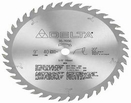 Like a machinery limitation, defects in a table saw’s blade are also notable agitators in the kickback movement. In certain circumstances, anything from a dull blade to a dirty blade can spit your workpiece back at you. In fact, dull, dirty, broken, bent or warped blades can cause kickback. Each of these cosmetic defects forces too much contact between wood and blade, generates too much friction heat, and grossly increases the chances that your blade will bite into your stock and fire back at you.
Like a machinery limitation, defects in a table saw’s blade are also notable agitators in the kickback movement. In certain circumstances, anything from a dull blade to a dirty blade can spit your workpiece back at you. In fact, dull, dirty, broken, bent or warped blades can cause kickback. Each of these cosmetic defects forces too much contact between wood and blade, generates too much friction heat, and grossly increases the chances that your blade will bite into your stock and fire back at you.
Using a blade that is not designed for the application being performed is another precursor to kickback. The most frequent errors in this camp involve operators using blades that are too fine or two small. Where a blade is too small (or doesn’t reach (on average) 1” to 1-1/2” above the stock being cut), the only downward pressure applied to the blade is manual and usually not sufficient. Eventually, the forward movement of the stock forces the piece upward with the forward edge of the blade; this, of course, will fling a workpiece in the direction the blade is spinning (which happens to be directly at the user). Additionally, where too-small blades are being used, more saw teeth are inside a workpiece at any given time and each saw tooth passes through a greater amount of material before exiting the stock. This generates excess heat, friction, and drag on the motor causing the motor to perform much closer to its stall level and encouraging a little (or a lot of) kickback.
Quite like a blade that is too small, a blade that is too fine does not provide enough downward force on a workpiece and similarly encourages lift-off. Accordingly, for your personal safety and for the integrity of your results, always use a saw blade that is designed for the task you’re performing. This will enhance the performance of your saw and the outcome of your work. You must also ensure your blades are clean, sharp, straight and intact; otherwise, you’ll end up with less-than-perfect results and possibly a piece of stock in your thigh.
Wood and Workpieces:
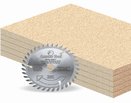 Kickback can also be caused by the wood or stock that’s being cut. In fact, under a few circumstances your workpiece itself might be the the biggest contributor to kickback. Stock with a twisting, knotted or locked grain, one with internal pressure, or wood that is wet or pitchy (sappy) will commonly result in kickback. These characteristics in a workpiece will introduce obstructions and obstacles between the blade and the stock and will produce too much friction during the cut. As aforementioned, this can forced the saw blade to bite and spit. Where pieces of sheet stock are thin, kickback can also occur if the stock is flexible enough to curl with the rotation of the blade (or if the sheet happens to be curled already). Accordingly, it is important to ensure your sheet stock is not allowed to lift off the saw table. Where sheet stock is wider than it is long, it is also crucial to ensure that that workpiece is not allowed to twist with the saw blade’s rotation (it is recommended that users employ a miter gauge to hold large pieces square). If lift or rotation occurs, a saw tooth (usually nearer the rear) will catch the piece and launch it forward; this causes the blade to dig rather than cut and produces, of course, kickback.
Kickback can also be caused by the wood or stock that’s being cut. In fact, under a few circumstances your workpiece itself might be the the biggest contributor to kickback. Stock with a twisting, knotted or locked grain, one with internal pressure, or wood that is wet or pitchy (sappy) will commonly result in kickback. These characteristics in a workpiece will introduce obstructions and obstacles between the blade and the stock and will produce too much friction during the cut. As aforementioned, this can forced the saw blade to bite and spit. Where pieces of sheet stock are thin, kickback can also occur if the stock is flexible enough to curl with the rotation of the blade (or if the sheet happens to be curled already). Accordingly, it is important to ensure your sheet stock is not allowed to lift off the saw table. Where sheet stock is wider than it is long, it is also crucial to ensure that that workpiece is not allowed to twist with the saw blade’s rotation (it is recommended that users employ a miter gauge to hold large pieces square). If lift or rotation occurs, a saw tooth (usually nearer the rear) will catch the piece and launch it forward; this causes the blade to dig rather than cut and produces, of course, kickback.
Operator Error:
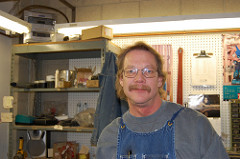 To address those few human-error instances where kickback is, really, an eventuality – if your table saw’s fence is positioned with even the slightest skew towards the blade, you will experience kickback. If there is insufficient downward pressure on the workpiece as it is fed into the saw, you will experience kickback. If you force a workpiece too quickly into a machine, if you force a machine to perform a task it cannot perform, if you use blades that are not designed for the task being performed, if you release a workpiece before is has entirely passed through the blade, if you attempt to cut a workpiece freehand, if you tilt the blade so that traps a workpiece between itself and the fence as it is fed through the saw, or if a workpiece is allowed or forced to move upward or sideways during a cut, you will experience kickback. In short, there a quite a few things that can elicit a kickback reaction. The best prevention, then, is focus and thoughtfulness in the shop. Don’t lose sight of the present and remember that if a saw blade is not cutting stock, it’s forcing it backward.
To address those few human-error instances where kickback is, really, an eventuality – if your table saw’s fence is positioned with even the slightest skew towards the blade, you will experience kickback. If there is insufficient downward pressure on the workpiece as it is fed into the saw, you will experience kickback. If you force a workpiece too quickly into a machine, if you force a machine to perform a task it cannot perform, if you use blades that are not designed for the task being performed, if you release a workpiece before is has entirely passed through the blade, if you attempt to cut a workpiece freehand, if you tilt the blade so that traps a workpiece between itself and the fence as it is fed through the saw, or if a workpiece is allowed or forced to move upward or sideways during a cut, you will experience kickback. In short, there a quite a few things that can elicit a kickback reaction. The best prevention, then, is focus and thoughtfulness in the shop. Don’t lose sight of the present and remember that if a saw blade is not cutting stock, it’s forcing it backward.
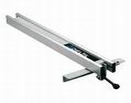 To explain with a trifle more depth, though, and to begin with your fence – as stock is fed into a machine with the aforementioned imperfect setup (skewed towards the blade), it will become pinched between the blade and the fence. Quite like trying to force a large peg into a smaller hole, the stock will not continue to feed into an opening that is not at least as wide as itself. As the pinching pressure grows too great, the stock will be pushed (by the fence) into the back of the blade and forced back out of the machine towards the operator.
To explain with a trifle more depth, though, and to begin with your fence – as stock is fed into a machine with the aforementioned imperfect setup (skewed towards the blade), it will become pinched between the blade and the fence. Quite like trying to force a large peg into a smaller hole, the stock will not continue to feed into an opening that is not at least as wide as itself. As the pinching pressure grows too great, the stock will be pushed (by the fence) into the back of the blade and forced back out of the machine towards the operator.
To ensure your fence is not the maniac behind a kickback attack, users must ensure that their table saw’s fence is either exactly parallel to the blade or, better yet, ever-so-slightly (perhaps the width of a piece of paper or card stock) skewed away from the blade. This ensures your stock has a clean, clear path through the blade and out the saw. Essentially, users must never allow the fence to be closer to the rear of the blade than the front.
As for keeping your grip, one should never let go of a workpiece in action. Despite staring horrified into the face of an impending kickback, do not let go of your stock. Your steadfastness might even prevent the kickback from occurring. Although there are certainly some circumstances that require an operator to abandon ship, for the most part, holding your ground is the safer alternative. Do not release a workpiece until it is past the blade and been removed from the saw.
In the event of imperfect initial stock placement (stock must be placed with the edge exactly butted against the fence) or a lack of downward pressure upon the workpiece as it’s fed, a “scewing” in the stock will occur that will trap a workpiece between the blade and the fence. Accordingly, one must always use the rip fence to guide stock while ripping and always keep downward pressure on the stock as it feeds. Additionally, not only does freehand cutting result in poor, crooked cuts, it can similarly trap stock and kick it back.
Riving Knives:
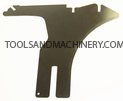 And finally, at the risk of now writing far too many words, kickback can also be caused by your riving knife. “What?!” You might exclaim, “my riving knife?!” And the answer will be “yes,” even your riving knife, that brilliant little device designed to prevent kickback from occurring can sometimes be the instrument behind it. Although having and properly using a riving knife will exponentially reduce the occurrence of table saw kickback, when used sloppily it can also throw a little wrench into your system. If your riving knife, who’s purpose is (in a very small nutshell) to keep a cut separated as a workpiece feeds through a table saw and to eliminate pressure on the blade from that workpiece as it feeds, is the same thickness as the kerf of your blade (the kerf being, simply, the width of the cut it produces or, of the cutting teeth themselves) it should be aligned with the blade. If the riving knife is thinner than the kerf of the blade, it should be aligned with the edge of the kerf that is closest to the fence. This should eliminate the riving knife from pinching or pushing and keep operators far more kickback free.
And finally, at the risk of now writing far too many words, kickback can also be caused by your riving knife. “What?!” You might exclaim, “my riving knife?!” And the answer will be “yes,” even your riving knife, that brilliant little device designed to prevent kickback from occurring can sometimes be the instrument behind it. Although having and properly using a riving knife will exponentially reduce the occurrence of table saw kickback, when used sloppily it can also throw a little wrench into your system. If your riving knife, who’s purpose is (in a very small nutshell) to keep a cut separated as a workpiece feeds through a table saw and to eliminate pressure on the blade from that workpiece as it feeds, is the same thickness as the kerf of your blade (the kerf being, simply, the width of the cut it produces or, of the cutting teeth themselves) it should be aligned with the blade. If the riving knife is thinner than the kerf of the blade, it should be aligned with the edge of the kerf that is closest to the fence. This should eliminate the riving knife from pinching or pushing and keep operators far more kickback free.
Conclusion:
So, in brief, use your saw and its corresponding accessories cautiously and correctly. Be conscious of the act you are performing, of the condition of your saw, and of the stock you are manipulating. This, although certainly a brain-full of information, should keep you running smooth and keep kickback at bay.













